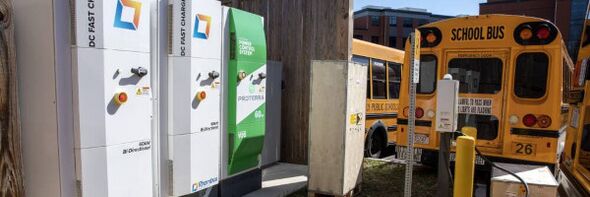Beverly Public Schools Electric Busses
| Beverly Public Schools Electric Busses | |
|---|---|
 Bus and Charger | |
| Team Organizations | Highland Electric Fleets Beverly Public Schools |
| Team Leaders | Dana Cruickshank |
| Participating Municipalities | Beverly MA |
| Sectors | Transportation Utility |
| Status | Implemented |
| Last Updated | May 1, 2024 |
Summary
Beverly Public Schools in Massachusetts has implemented a project utilizing their electric school buses as on-demand power plants. By using bidirectional chargers, the buses' large batteries can both charge and send energy back to the grid, providing backup power during high-demand periods.
Managed by Highland Electric Fleets, the project began with one bus in 2021 and has expanded to include multiple buses, selling significant energy back to the grid. This innovative approach not only reduces reliance on polluting peaker plants but also demonstrates the potential for electric buses to contribute substantial power to the grid if widely adopted. National Grid, partnering with Highland Electric Fleets, supports this initiative and foresees a growing interest in such technology among other school districts. Beverly Public Schools' success has inspired interest from other districts, highlighting the potential for collective action in addressing environmental challenges.
Challenges
- Technical Complexity: The project involves bidirectional chargers, managing charging and discharging cycles, and integrating bus batteries into the grid. This requires sophisticated software and hardware coordination.
- Infrastructure Setup: Constructing chargers on-site and ensuring they meet safety and regulatory standards can be a logistical challenge, especially for schools with limited resources.
- Maintenance and Training: Maintaining electric buses and training drivers on new technology adds operational complexity and ongoing costs.
- Coordination with Utility Companies: Collaborating with utility companies like National Grid requires effective communication and coordination to ensure timely responses to grid demand.
- Scalability: While the project has been successful with a few buses, scaling up to a larger fleet or replicating it in other districts requires careful planning, investment, and support.
- Cost Management: Balancing the costs of electric buses, infrastructure setup, maintenance, and operational expenses against the benefits of grid services and environmental impact requires careful financial planning and management.
Solutions
- Grid Stability: By using bidirectional chargers and bus batteries, the project provides backup power during high-demand periods, contributing to grid stability without relying solely on polluting peaker plants.
- Environmental Impact: Utilizing electric buses reduces emissions and supports clean energy initiatives, aligning with sustainability goals and reducing the carbon footprint of transportation and energy sectors.
- Resource Optimization: Electric buses, which typically sit idle during summer breaks, are effectively utilized to provide grid services, maximizing the value of existing resources and infrastructure.
- Cost Efficiency: Despite the technical complexity and infrastructure setup, the project aims for cost efficiency by leveraging partnerships with companies like Highland Electric Fleets and utility companies. This model makes it financially viable for school districts to adopt similar initiatives.
- Scalability and Replicability: While initially implemented in Beverly Public Schools, the project's success demonstrates scalability and replicability potential for other districts, contributing to a broader adoption of electric vehicle technology and grid integration strategies nationwide.
Requirements
- Electric Buses: The project requires the use of electric school buses equipped with lithium-ion batteries capable of bidirectional charging and discharging.
- Bidirectional Chargers: Infrastructure must include bidirectional chargers that can both charge the bus batteries and allow them to send energy back to the grid.
- Software Integration: Sophisticated software is needed to manage charging and discharging cycles, monitor grid demand, and coordinate with utility companies for grid services.
- Infrastructure Setup: Installing chargers on-site and ensuring compliance with safety and regulatory standards is essential.
- Partnerships: Collaboration with companies like Highland Electric Fleets for bus leasing, maintenance, and driver training, as well as partnerships with utility companies for grid integration and coordination.
- Financial Planning: Effective cost management strategies are necessary to balance the upfront costs of electric buses and infrastructure setup with the long-term benefits and revenue from grid services.
- Scalability Plan: Developing a plan for scaling up the project to include more buses or replicating it in other districts, considering factors like funding, infrastructure expansion, and operational scalability.
- Training and Education: Providing training and education to bus drivers, school staff, and stakeholders about the technology, benefits, and operational procedures involved in using electric buses for grid services.
- Regulatory Compliance: Ensuring compliance with regulations and standards related to electric vehicle operation, grid interconnection, and energy market participation.
Key Performance Indicators
- Energy Contribution to Grid: Measure the amount of energy (in megawatt-hours) that the electric buses contribute back to the grid during peak demand periods.
- Revenue Generation: Calculate the revenue generated from selling energy services back to the grid, considering factors like energy prices, demand response programs, and market participation.
- Grid Stability Impact: Assess the project's impact on grid stability, such as reducing reliance on peaker plants, improving grid resilience, and supporting renewable energy integration.
- Environmental Benefits: Quantify the environmental benefits of using electric buses, including reductions in greenhouse gas emissions, air pollutants, and fossil fuel consumption.
- Operational Efficiency: Evaluate the efficiency of bus charging and discharging operations, including uptime, response time to grid signals, and overall system reliability.
- Cost Savings: Measure cost savings achieved through reduced energy costs, lower maintenance expenses compared to traditional buses, and potential incentives or subsidies for grid services.
- Scalability and Replicability: Assess the feasibility and success of scaling up the project to include more buses or replicating it in other districts, considering factors like infrastructure expansion, funding sources, and stakeholder engagement.
- Customer Satisfaction: Gather feedback from stakeholders, including school officials, bus drivers, utility partners, and community members, to gauge satisfaction with the project's outcomes, benefits, and overall performance.
- Regulatory Compliance: Ensure compliance with regulatory requirements, standards, and agreements related to electric vehicle operation, grid interconnection, energy market participation, and environmental regulations.